Are you interested in DJing with digital music files, but you want to use decks that give the look and feel of playing on vinyl? Maybe you like the idea of adapting existing record decks so they can be used with digital music files?
In this article, we’ll look at why you may want to do this as a DJ today, review your options (both specialised equipment designed for this, and ways you can adapt existing DJ gear), and give you advice and tips to help you get started.
Watch the show
Prefer me to talk you through this? In this video, a recording of a live show from the Digital DJ Tips YouTube channel, I talk you through everything in this guide, and we take questions from our community too on the subject.
The Best Vinyl Options For Digital DJs – Contents
- Specialised vinyl equipment
- Adapting an existing turntable/mixer set-up (“DVS”)
- What Is Digital Vinyl Like To Use?
- Which System Is Best?
Why DJ using a “vinyl” set-up?
When we talk of a “vinyl” system we mean decks that look similar to old-fashioned turntables. That could be because they are old fashioned turntables with some digital tweaks, or that they’re been manufactured to appear that way, ie they’re motorised, and have “real” vinyl on the top with slipmats underneath – just as DJ turntables have always had.
But why – in this age of amazing DJ controller and media players that don’t have vinyl and spinning platters – would you want to do this?
- If you’ve come from a vinyl background, you may prefer the feel of DJing this way, and not wish to give this up, even though you now want to move away from playing with actual records
- Maybe the type of DJing you do – eg hip-hop, scratching/turntablism – leans towards using “vinyl” decks
- It could be that you feel doing it this way will connect you better to where DJing came from
- You may still want to sometimes DJ that way, with real records, and so you’re looking for a system that lets you play “real” records and digital files side-by-side
- You may just feel playing on a set-up that looks like a traditional DJ system just looks better. Mobile and wedding DJs, for instance, who are charging top money, often tell us that this kind of set-up gives the right impression to their high-paying clients
Whatever your reason then, you’re here because you’re interested in how this is done, or even in making the switch. So let’s look at the five ways you can do it:
5 Vinyl Options For Digital DJs
i. Specialised vinyl equipment
Our first three options use equipment manufactured specially to DJ with digital music files, but with motorised, vinyl-topped platters. This of course means that these systems can’t also play “real” vinyl – these are 100% digital solutions.
1. Rane Twelve deck controller
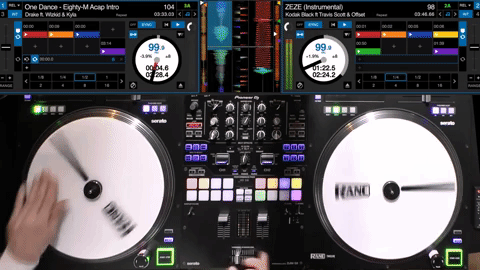
This is a full-sized (12”) motorised deck controller, with vinyl and slipmats, designed to work with Serato DJ Pro – you’d pair two alongside a DJ software-enabled mixer.
Learn more: Rane Twelve Serato DJ Controller
2. Denon DJ SC6000M media player
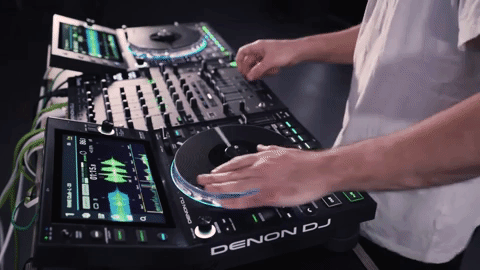
A mid-sized (10” platter) motorised media player, with vinyl and slipmats – you’d add a pair of these to any DJ mixer for a fully standalone digital “vinyl” set-up, spinning from an attached drive with your music on it.
Go to the Denon DJ SC6000M review & video
3. Rane One/Pioneer DJ DDJ-REV7 controllers
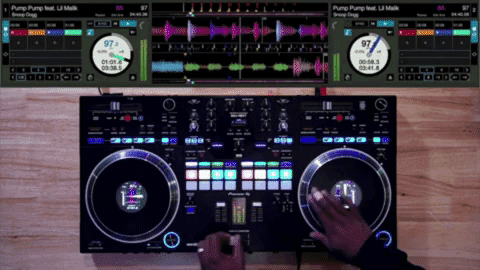
Two options here for a Serato DJ Pro controller with two spinning platters featuring 7” vinyl/slipmats. Controllers have built-in mixers, giving all you need in one box (just add laptop).
Go to the Rane One review & video
Go to the Pioneer DJ DDJ-REV7 review & video
ii. Adapting an existing turntable/mixer set-up (“DVS”)
A Digital Vinyl System (DVS) takes existing analogue turntables and turns them into control decks for DJ software. In this realm, you have two choices of tech:
4. Standard DVS
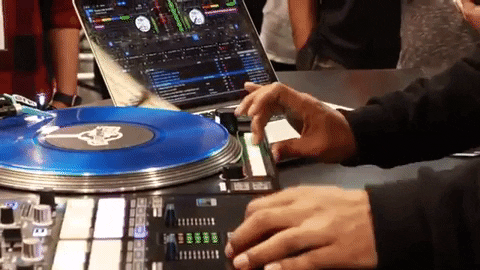
You buy “timecode vinyl” for your turntables – special records containing computer code that your DJ software can understand. Then, you plug your laptop into the mixer (which also has to be compatible with your DJ software). By playing the “records”, you control the software decks.
Learn more: A Beginner’s Guide To Digital Vinyl Systems
5. Wireless DVS
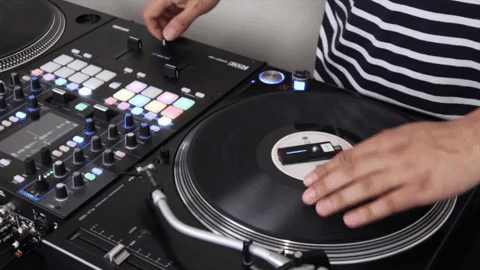
There is a popular solution called “Phase”, which achieves the above wirelessly using two little “puck” transmitters that fit over the spindles of the turntables, and a receiver that plugs into the mixer and laptop. It works best with Serato DJ Pro, and has the advantage of working with any DJ mixer.
Learn more: Wireless Scratch System Phase Gets Major Update
What Is Digital Vinyl Like To Use?
Firstly, don’t get too hung up on whether the “vinyl” and platter are 7”, 10” or 12” – all work brilliantly, and even DJs like DJ Jazzy Jeff, one of the best scratch DJs in the world (and a Digital DJ Tips tutor, of course – check out his How To DJ Right course), are happy to play on all sizes of motorised platters.
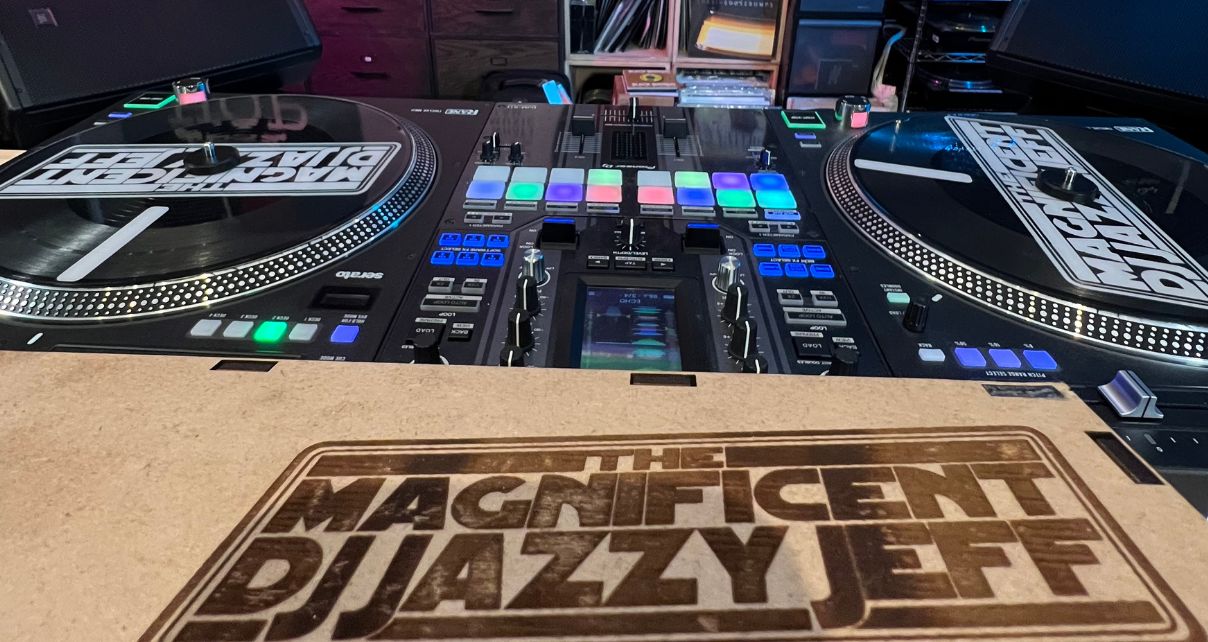
If you’ve been paying close attention, though, you may now also be wondering how some of these solutions work – because of course all except the real turntables don’t actually have a tone arm and needle to drop on the “record”.
So with real turntables and timecode vinyl, you have the option of what’s called “absolute” mode, which mimics absolutely real vinyl – drop the needle at the start of the timecode vinyl, you’re at the start of the track, and if it skips? It skips!
But you also have the option (and it’s the only option with all the other systems) of “relative” mode. This mode only follows the rotation info from the decks, not positional info. Effectively the platters are acting like big jogwheels, meaning you can also use cues, loops etc. Nowadays this is the most popular way such kit is used.
Read this next: The 7 Most Popular DJ Set-Ups Today
Which System Is Best?
If you have existing decks you don’t want to get rid of, and you’re prepared to invest in a DJ-software compatible mixer (click here to go to our mixer reviews), probably the simplest way is to grab some timecode vinyl. Buy a mixer that also controls your software, as modern scratch mixers do, and you’ll be all set.
That said, Phase can work with literally any turntable set-up, and as long as you don’t mind charging its built-in batteries between DJ sets, it is a versatile and elegant way of achieving the same.
If you want the vinyl “feel” but you don’t want a laptop in the DJ booth with you, it’s easy – the Denon DJ SC6000M players are your only choice, and you can pair them with any mixer you like.
Learn to scratch like a pro on ANY gear: Scratching For Controller DJs
But if you’re happy to use software and a laptop (and by the way, for “digital vinyl”, Serato is by far the number one software choice), you need to choose between separates (which would be the Rane Twelves plus a Serato-compatible mixer), and a controller (either the Rane One or Pioneer DJ DDJ-REV7 – both are excellent).
Separates are more “pro” but cost a lot more and are less portable; many DJs, even pros, prefer the overall ease of use a controller offers.
Finally, do bear in mind that you absolutely don’t NEED a “vinyl feel” to DJ digitally – ultimately it’s just a feel thing, a preference. But if you do choose to go down this route, this article has all you need to both further your research, and make the right choice for you.




